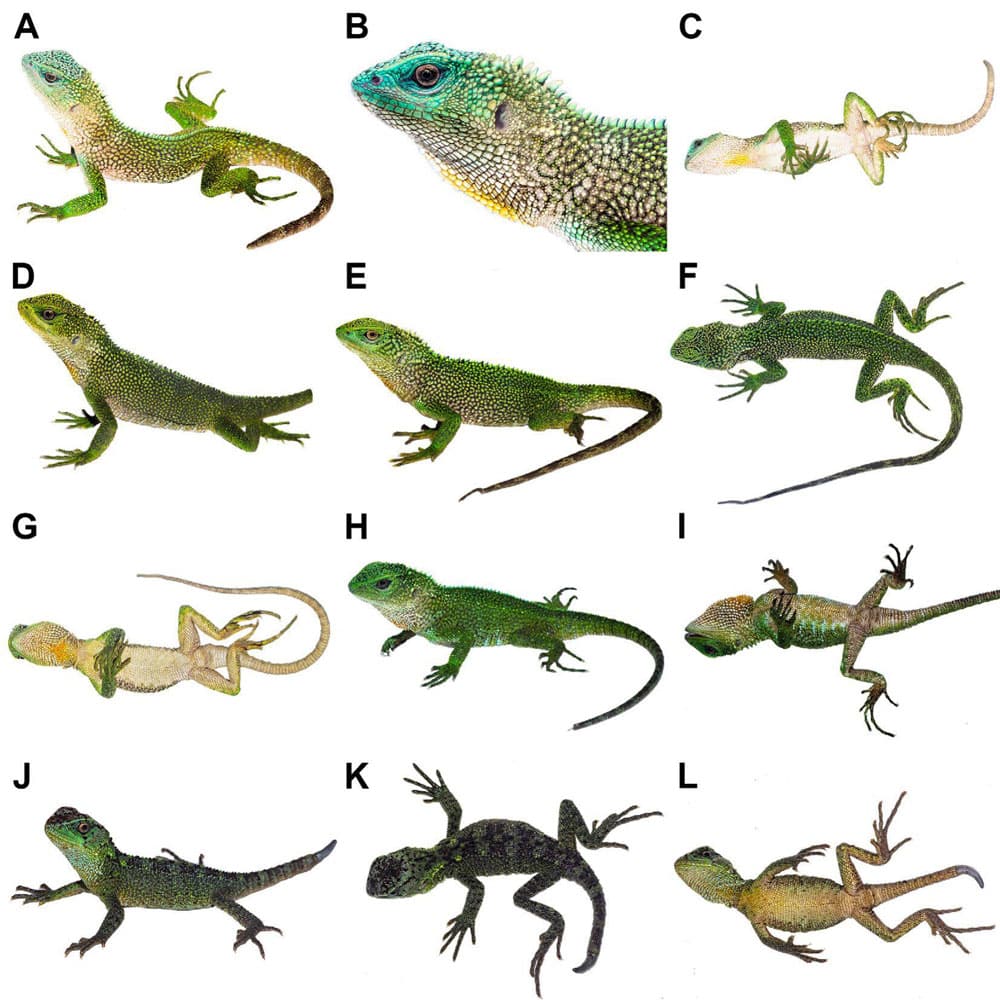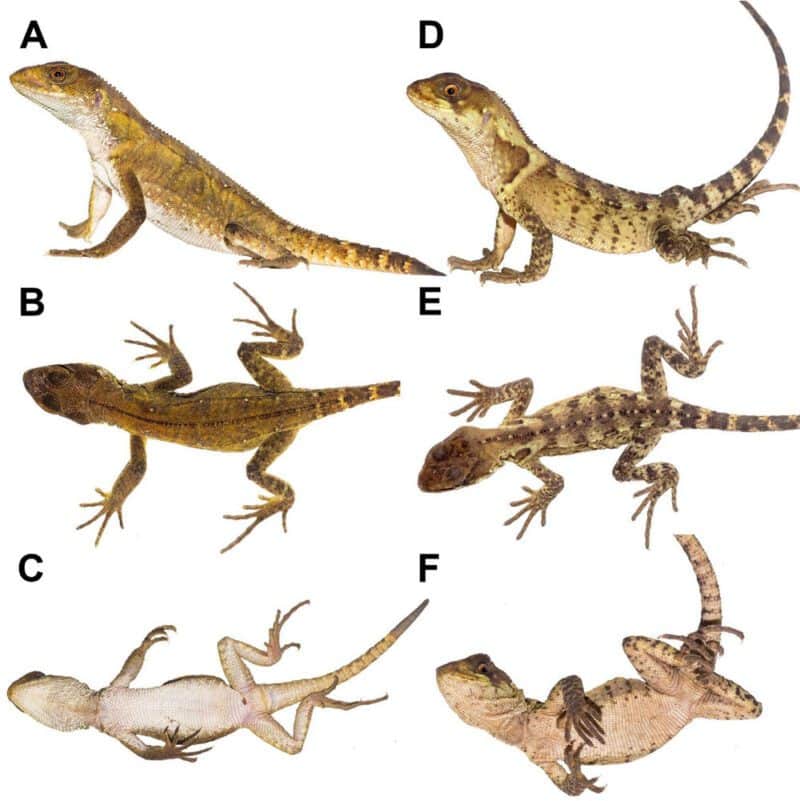Peruvian researchers have recently identified and described two new species of wooden lizards belonging to the genus Enyalioides. These lizards were discovered in the Cordillera de Colán mountain range and the Río Marañón and Río Chiriaco basins in Peru.
One of the newly discovered species, Enyalioides dickinsoni, was named after the lead singer of the heavy metal band Iron Maiden, Paul Bruce Dickinson. This lizard was found in the Cordillera de Colán mountain range, located 460 miles north of Lima, Peru. It is known to inhabit three different locations, including coffee plantations, cacao and citrus farms, as well as cow pastures and mountainous forests at elevations ranging from 4,600 to 5,600 feet (1,405-1,717 m).
The adult male specimens of Enyalioides dickinsoni can grow up to 11 inches in length and have spiky scales covering their bodies, with a spiked crest running down the back of both males and females. Their coloration varies from greenish with yellowish spots, both pronounced and subtle, and white throats. Females can range in color from dark brown to pale greenish, with some having black bands on their tails while others lack any banding. The bellies of these lizards are white to yellowish in color. The snout to vent length of the Dickinson’s lizard ranges from 92mm to 113mm.
The other newly discovered species, Enyalioides dickinsoni, was named after the lead singer of the heavy metal band Iron Maiden, Paul Bruce Dickinson. This lizard was found in the Cordillera de Colán mountain range, located 460 miles north of Lima, Peru. It is known to inhabit three different locations, including coffee plantations, cacao and citrus farms, as well as cow pastures and mountainous forests at elevations ranging from 4,600 to 5,600 feet (1,405-1,717 m).
The adult male specimens of Enyalioides dickinsoni can grow up to 11 inches in length and have spiky scales covering their bodies, with a spiked crest running down the back of both males and females. Their coloration varies from greenish with yellowish spots, both pronounced and subtle, and white throats. Females can range in color from dark brown to pale greenish, with some having black bands on their tails while others lack any banding. The bellies of these lizards are white to yellowish in color. The snout to vent length of the Dickinson’s lizard ranges from 92mm to 113mm.
The newly discovered species, Enyalioides dickinsoni, was named after the lead singer of the heavy metal band Iron Maiden, Paul Bruce Dickinson. This lizard was found in the Cordillera de Colán mountain range, located 460 miles north of Lima, Peru. It is known to inhabit three different locations, including coffee plantations, cacao and citrus farms, as well as cow pastures and mountainous forests at elevations ranging from 4,600 to 5,600 feet (1,405-1,717 m).
The adult male specimens of Enyalioides dickinsoni can grow up to 11 inches in length and have spiky scales covering their bodies, with a spiked crest running down the back of both males and females. Their coloration varies from greenish with yellowish spots, both pronounced and subtle, and white throats. Females can range in color from dark brown to pale greenish, with some having black bands on their tails while others lack any banding. The bellies of these lizards are white to yellowish in color. The snout to vent length of the Dickinson’s lizard ranges from 92mm to 113mm.
In addition to the physical characteristics, the researchers also noted the habitat of Enyalioides dickinsoni. This species can be found in various environments, including coffee plantations, cacao and citrus farms, as well as cow pastures and mountainous forests. This information is important for understanding the distribution and behavior of these lizards.
The researchers also provided detailed descriptions of the male and female specimens, including their size, coloration, and physical features. They also included photographs of the lizards, showcasing their unique appearance.
The discovery of these two new species adds to the diversity of the Enyalioides genus and highlights the importance of continued research and conservation efforts in the Peruvian region. These findings also serve as a reminder of the vast and diverse wildlife that still remains to be discovered and protected.
New Species of Enyalioides Discovered in South America
A recent study has revealed the discovery of a new species of lizard in South America, named Enyalioides cyanocephalus. This species is closely related to Enyalioides anisolepsis, but can be distinguished by its green dorsal background in males and brown coloration in females. The males also have a distinct orange patch on their throat area.
Distribution and Habitat
Enyalioides cyanocephalus is found in the Amazon slope of the Andes mountains in Southern Ecuador and northern Peru. It has been recorded in four different localities, with two in the Río Marañón basin and two in the Río Chiriaco basin. This species inhabits montane forests, as well as cropland and cattle pastures.
Physical Characteristics
Female specimens of Enyalioides cyanocephalus have an average SVL (snout-vent length) of 102 mm, while males have an average SVL of 112 mm. Juvenile females have an average SVL of 46 mm. This species is known to sleep at night between 0.2 to 1.8 meters above the ground, on stems of trees and plants.

Female specimens of Enyalioides cyanocephalus sp. nov.: (A-B) adult female CORBIDI 20737, SVL = 112 mm; (C-E) adult female CORBIDI 22498, SVL = 102 mm; (F-G) juvenile female CORBIDI 22495, SVL = 46 mm; (H-I) adult female CORBIDI 20726, SVL = 102 mm; and (J-L) juvenile female CORBIDI 22496, SVL = 44 mm (photo by Axel Marchelie).
Behavior and Adaptations
Enyalioides cyanocephalus is a diurnal species, meaning it is active during the day. It is also known to be arboreal, spending most of its time in trees and plants. This species has adapted to its environment by developing a green dorsal background in males, allowing them to blend in with their surroundings and avoid predators.

Female specimens of Enyalioides dickinsoni sp. n.: (A-C) adult female CORBIDI 21711, SVL = 87 mm; (D-F) juvenile female CORBIDI 21710, SVL = 83 mm (photo by Axel Marchelie).
Conservation Status
Currently, there is not enough data to determine the conservation status of Enyalioides cyanocephalus. However, as with many other reptile species, habitat destruction and fragmentation pose a threat to its survival. Further research and monitoring of this species is needed to fully understand its population and conservation needs.
In Conclusion
The discovery of Enyalioides cyanocephalus adds to the growing list of unique and diverse reptile species found in South America. Its distinct coloration and behavior make it a fascinating addition to the Enyalioides genus. Continued research and conservation efforts are crucial in protecting this newly discovered species and its habitat.
Colourful Species Of Wooden Lizard Discovered In Peru
A recent discovery in the Cordillera de Colán region of north-eastern Peru has revealed two new species of wood lizards, Enyalioides cyanocephalus and Enyalioides anisolepsis. These colorful reptiles have unique characteristics that set them apart from other wood lizards.
Enyalioides cyanocephalus, also known as the blue-headed wood lizard, is easily distinguished by its turquoise head and scattered black scales on its dorsal side. Its neck, body, and crest have a different scalation compared to other wood lizards. The holotype of this species has a snout to vent length of 110mm and a total length of 112mm. Its ventral surface is whitish with a dirty cream coloration at the tip of its tail.
On the other hand, Enyalioides anisolepsis, or the green wood lizard, has a greenish hue on its neck and a pale green crest. Its throat is grayish white, and its ventral surface is whitish. This species has a snout to vent length of 121mm and a total length of 106mm.
The discovery of these two new species was made possible by the efforts of researchers from the Cordillera de Colán Biological Station and the Centro de Ornitología y Biodiversidad (CORBIDI). The findings were published in the Journal of Vertebrate Biology.
Wood lizards are known for their vibrant colors and unique characteristics, making them a popular choice among reptile enthusiasts. With the addition of Enyalioides cyanocephalus and Enyalioides anisolepsis, the diversity of wood lizards in Peru has increased, highlighting the importance of conservation efforts in the region.
To learn more about these fascinating creatures, you can read the full paper on the Journal of Vertebrate Biology website. Keep an eye out for these colorful wood lizards on your next trip to Peru!


This is such a creative and unique way to honor a legendary band and their lead singer! Can’t wait to learn more about this new wooden lizard species. 🦎🤘